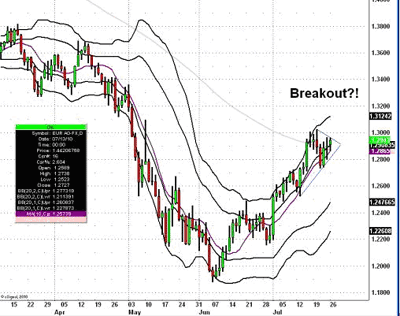The European stress tests are now behind us, and unfortunately, they failed to be the buzzkill or euphoric event that was needed to break the EUR/USD out of its recent trading range. The goal of the stress tests was to restore confidence in the European banking sector, but based upon the price action in the currency and European equity markets this morning, investors were not impressed. The results scream leniency because all of the big European banks passed, and those that failed were either very weak to begin with or already expected to do so. There will be no major capital injections into the banks—which was what followed the US stress tests and was instrumental in rebuilding confidence in US banks.
Despite some intraday volatility on Friday, the EUR/USD has been virtually unchanged since Thursday. However, the formation in the charts tells us that the currency pair is prime for a breakout. The 1.30 resistance and 1.28 support levels probably won’t hold for long, even as we head into August, when the doldrums of summer are at their highest. Based upon the price action and the prospect of stronger European and weaker US data this week, I believe that the breakout will be to the upside. It should be just a matter of time before the EUR/USD breaks the 1.30 level, paving the way for further gains.
EUR/USD Daily Chart
Can We Trust the Stress Test Results?
The $600-million question is whether or not we can trust the stress test results. Excluding the risk of a sovereign default immediately undermined the credibility of the results, as earlier this year, many people in the market were convinced that Greece would default on their debt. Also, having such a small amount of banks fail the tests screams leniency. By only evaluating the bonds on the trading books and not those held to maturity, the tests ignored a large amount of debt on the banks’ balance sheets, which will receive significant backlash and criticism. The stress tests may have been modeled off the US tests, but the credibility pales in comparison. When the US conducted its tests, ten out of 19 banks failed. By passing more than 90% of the banks, the EU did not require them to boost their rainy day fund, which in the long run would have been good. More than 50% of the failing banks were in Spain, which could also increase focus on the country’s risks. However, the Bank of Spain has a restructuring fund in place to provide support for capital shortfalls. There is no question that the results were not as tough as the market had hoped, but the event risk that the market had been obsessing over for the past month is now behind us.



















